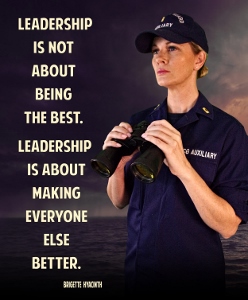Level 2 Leadership BC, BA, FC, VFC, FSO,
Branch Chief, Flotilla Commander, Vice Flotilla Commander, Flotilla Staff Officer

Fundamental to successful development as a leader is an understanding of self and one’s own abilities. This includes understanding one’s personality, values, and preferences, while simultaneously recognizing one’s potential as a member of the Coast Guard team. Personal conduct, health and well-being, character, technical proficiency, lifelong learning, followership, and organizational commitment are elements to consider when setting short and long-term goals focused upon the leadership development of “self.”
Leadership involves working with and influencing others to achieve common goals and to foster a positive workplace climate. Auxiliarists interact with others in many ways, whether as supervisor, mentor, manager, team member, team leader, peer or worker. Positive professional relationships provide a foundation for the success of our Service. Showing respect for others, using effective communications, influencing others, working in teams, and taking care of one’s people are elements to consider when evaluating one’s capacity for leading others. Developing these qualities will increase capacity to serve.
Methods for Gaining and Demonstrating Competence
Auxiliarists are a diverse group. Some have extensive civilian leadership training and experience. Others have had more limited opportunities. To ensure success the Auxiliary needs capable leaders at all levels in the organization. The above sections define the minimum expectations for leaders at each level in the Auxiliary. This section identifies the intended performance level targets for each of the major Auxiliary leadership training courses.
In addition to Auxiliary training courses, there are other resources available to Auxiliarists. Check with your Member Training Staff Officer for available sources.
Many Districts publish District Policy Manuals. Auxiliary members at all levels are encouraged to utilize these resources.
The section below describes the specific leadership/management courses intended for each level and the minimum performance level targets for each of these in terms of the 28 leadership competencies expected of graduates of these courses. Three target performance levels are included:
1. Awareness: The Auxiliarist is aware of the concept and can define its meaning.
2. Application: The Auxiliarist is capable of applying the concepts and principles of the leadership competency in his/her customary work environment (e.g., at the Flotilla, Division, District, or National Levels).
3. Overall responsibility: The Auxiliarist has awareness, application skills, and overall responsibility for ensuring that members in their care have sufficient training and skills.
In the descriptions below, these three levels (awareness, application, overall responsibility) are denoted 1, 2, and 3 respectively.
Level Two (FC, VFC, FSO, BC, BA)
Auxiliarists at level two have completed the Basic Qualification Course (BQC) and (in many cases) the Auxiliary Procedures Course (APC). Additionally, they should have completed more advanced Auxiliary Leadership and Management School (AUXLAMS). However, the course specifically targeted for this group is the Auxiliary Flotilla Leadership Course and local or District Flotilla Commanders Academy (FCA).
In the categories of “Leading Self” and “Leading Others” the performance levels are typically “2s,” meaning that they have not only an awareness, but also are qualified to apply these competencies. In the competency groups “Leading Performance and Change” and “Leading the Auxiliary” with a few exceptions (e.g., conflict management, customer focus, financial and HR management) the anticipated target performance levels are all “1s.”